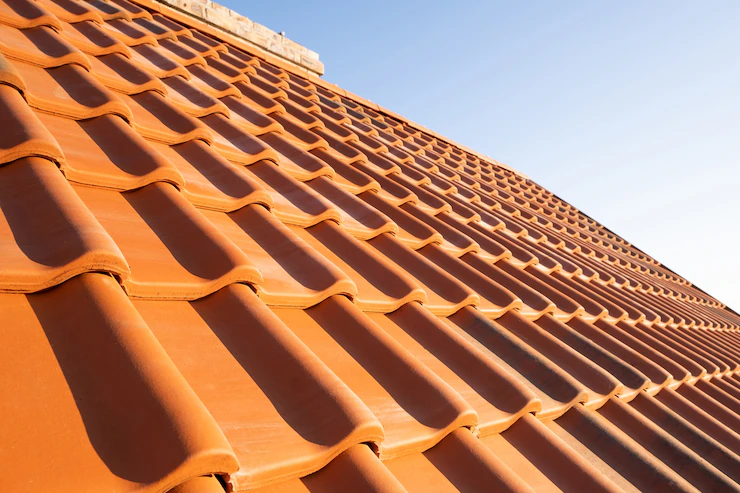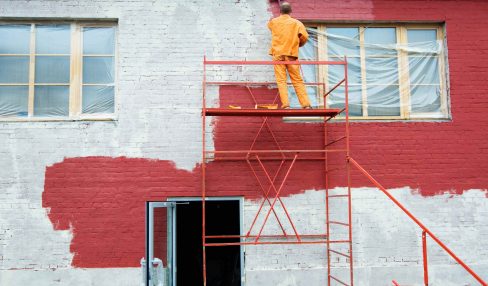Roofing Options: Trending Materials For Modern Architecture
5 Mins Read
Published on: 09 November 2023
Last Updated on: 16 September 2024

toc impalement
Roofing materials and coatings have improved significantly in recent years.
This progress has addressed concerns such as installation time, labor effort, durability, insulation, flexibility in design, and aesthetics.
Therefore, it made it easier to install and maintain roofs while also providing more options for design and appearance.
To maintain comfortable interiors and save energy costs, modern architects place a high priority on exterior design. Therefore, they prefer using cutting-edge materials like metal, clay, concrete, and ceramic roofing tiles.
Due to their weight and maintenance requirements, traditional roofing materials like clay and slate tiles have become less common.
Using innovative technology, contemporary roofing materials can replicate their look. However, they do not require the weight or upkeep of natural materials.
So, let’s explore modern roofing materials for your exterior revamp or construction.
Modern Roofing Materials
In this era, a skilled roofer would prefer to work with home and building owners who care about the environment. Therefore, materials have also changed according to the modern crises.
Given elbow are some of the widely used materials that are used and suggested by modern architects for your roof—
1. Composite
Unlike natural materials like slate and wood, synthetic or composite roofing materials are more durable and sturdy.
They are resilient to severe weather and winds of up to 110 mph.
Composite roofing materials offer a cost-effective and safer alternative to actual slate roofs. They are more durable against harsh weather conditions and fire and environmentally friendly.
Composite roofing materials are resilient to severe weather, winds of up to 190 mph, and hailstorms. They are also fire retardants and aid in the prevention of algae growth.
Therefore, for homeowners, composite roof tiles—which resemble slate, asphalt, or cedar shake roofing—offer several advantages.
With a lengthy lifespan of 30 to 50 years, high weather resilience, and affordability, they are environmentally benign, robust, and economical.
2. Green Roofing
A green roof is a stabilized and autonomous layer of plants that is put on a level or gently sloping roof.
By offering insulation, thermal mass, and shading, it lowers the energy consumption of buildings.
Additionally, green roofs increase biodiversity by giving plants and animals new urban habitats. This insulating layer lowers summer cooling requirements and winter heat demand.
Moreover, they can remove airborne pollutants through leaves and improve air quality. They draw particles to soil and vegetation and reduce stormwater runoff by up to 65%.
Therefore, green roofs help in the formation of natural habitats by luring insects, birds, and bees.
They can hold onto up to 95% of the water and are strong, lasting 40 years or more. Green roofs also greatly increase the species richness of a region.
Read More: Pros And Cons Of Working In The Home Improvement Industry
3. Metal
Metal roofing sheets have evolved from a rustic appearance. Now, they look more sleek and versatile and highlight the style and structure of modern structures.
Therefore, this adaptable material accentuates the design of contemporary buildings.
Architects and homeowners have a variety of options to choose from when it comes to roofing. Moreover, there are different architectural profiles available, such as standing seam and corrugated panels.
Standing seam roofs have a sleek, contemporary look, and corrugated panels give it a charming, industrial feel.
Additionally, metal roof tiles come in slate, cedar shake, and tile styles that look like other roofing materials but are low maintenance, long-lasting, and durable.
They make the exterior of the building look visually interesting with striking contrasts when used with other materials.
Lastly, a metal roof and wood-clad façade can produce a warm, modern look.
4. Asphalt Shingles
Asphalt roofing shingles are made to endure severe weather and unforgiving outside elements.
Therefore, consider purchasing impact-rated Class 4 shingles if you live in a region that experiences frequent storms or hail.
These shingles are reasonably priced, strong, energy-efficient, environmentally benign, adaptable, lightweight, and wind-resistant.
Moreover, they are adaptable, have a large selection, and can assist in reducing home temperatures by a few degrees.
They also come with lengthier manufacturer’s warranties—up to 50 years in certain cases. This makes them an affordable option for homes in storm-prone locations.
5. Solar Shingles
Small solar panels called “solar shingles” are integrated into the roof to produce electricity instead of more conventional roofing materials.
Utilizing building-integrated photovoltaic (BIPV) technology, they collect solar energy and function as roofing.
Therefore, they offer protection from storms, are fire-resistant, and may outlast more conventional materials like asphalt.
These solar shingles weigh 13 pounds per square foot. Moreover, they are roughly the same size as standard roofing shingles. Therefore, they measure an average of 12 inches broad by 86 inches long.
Solar shingles also offer the same power output even if there are more cost-effective and efficient solutions.
Therefore, these shingles are an affordable substitute for conventional roofing materials. They are a component of building-integrated photovoltaics or BIPV.
6. Slate
Since ancient times, slate has been a popular material for roofing shingles because of its high water absorbency index—less than 0.4%.
As a result, it is impervious to freezing and frost damage and is waterproof. Moreover, slate resists heat. Therefore, it can be used in warmer locations.
This protective material safeguards the interior and structure of your home. It protects it from wind, hail, rain, ice, and debris. However, its impact-resistant nature makes it highly preferable among modern architects.
Slate is a type of roofing material that is known for its durability and longevity. With a lifespan of up to 100 years, slate is a popular choice for homeowners who want a roof that will last for decades.
Therefore, slate is a reliable and practical choice for homeowners who want a long-lasting and energy-efficient roofing option.
Choose Your Roofing Material Wisely
Modern roofing materials come a long way in terms of style and design. These materials have adapted to modern architecture with a wide range of options.
Additionally, eco-friendly roofing materials have become a popular choice for modern buildings. This is due to their combination of style and sensitivity to the planet.
Therefore, roofers offer a range of options, including bold color choices, mixed materials, and green roofing solutions.
Moreover, emphasis is placed on roof accessories and details, with a variety of architectural profiles available.
Lastly, roofing materials are no longer simply utilitarian. Rather, they became fashionable to fit perfectly with contemporary buildings.
Therefore, with these features, homeowners and architects can enhance the visual appeal and aesthetics of their properties. So choose wisely and protect your home!
Read Also:


















Comments Are Closed For This Article